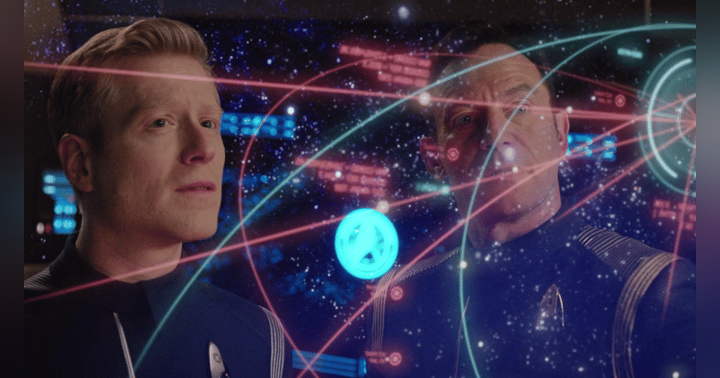Imagine this scenario with me: you have an employee or team member who notices a problem at work. They fix the problem but, in the process, create multiple new problems. Now it’s your responsibility to bring their attention to these mistakes. Yikes. How are you going to go about that? What’s your tone? Are you going to ask a superior for guidance?
This type of back and forth is exactly what happened between Tuvok and Dalby in this episode, and for them, it didn’t go well. Let’s take a deeper look at the situation, what could have been done differently, and ultimately, what leadership skills we can glean from this scenario. I’m going to give you a hint: it all revolves around coaching.
In the season finale of Voyager, Learning Curve, we find crewman Dalby, a former Maquis, fixing a bioneural gel pack that was malfunctioning. He noticed a problem and took the initiative to solve it. Tuvok tells him he failed to follow protocol when doing his repairs and caused a number of system failures. Dalby fires back right away, “I was just doing my job, saw something broken, and tried to fix it.” The altercation becomes a Maquis vs. Starfleet issue, and Tuvok fails to salvage it. Dalby had the best of intentions. It was his execution that was wrong. So, how important are intentions anyway?
As a leader, you must consider the person’s intent just as much as their approach. Tuvok is singularly focused on the execution and the negative consequences of that execution. Those are serious and need to be addressed. But if he had assumed good intent, he could have slowed down enough to listen to Dalby, hear his explanation, and respond in a very different way that would have produced a very different outcome. This doesn’t mean everyone gets a pass every time because they had good intentions. However, when you assume a person has positive intent, it can change a lot. For example, Tuvok could have started with:
“I appreciate that you were doing your job, Crewman Dalby. It is refreshing to see someone take the opportunity to solve a problem. Were you aware that your repairs shut off some critical systems and affected others too?” Dalby might have answered, “No, I didn’t know that.” So Tuvok would have continued, “That’s why we have established protocols for this type of work. Conferring with your division officer would have shed some light on this issue and avoided the problems. These problems can be solved, and I will go ahead and set up some training on these protocols so that you’ll be up to speed.”
Do you see the difference? This type of intentional communication can change a “That report was completely wrong. Do it again. And this time do it the way I asked.” to: “Thanks for getting me the report. I know you intended to get it done on time and right, but there are some problems with it. Would you like to go over it with me so I can show you how to get it right, or is the attachment I sent enough information?” Strong leadership is not about correcting someone sternly and walking away. A powerful and influential leader has the humility to ask questions, offer positive observations, and then proceed kindly into the necessary corrections after all the facts have been made clear.
In this instance, the truth of the matter is that the Starfleet crew went through the Academy for years. Protocol had been drilled into them and made a part of their routine. Dalby has not had this same privilege, and he shouldn’t be expected to perform at the same level. This is a training problem, not a performance problem! Most people don’t want to do a lousy job. When they do, it’s usually the result of not knowing how to do what they are doing or a lack of clearly communicated expectations. When your people make mistakes, identify the training gap and put a solution into place.
Some time ago, Charlie Kim, the CEO of Next Jump, said they would no longer be firing low-performing employees. Instead, the company would offer additional training and resources. Put simply, they consider an employee’s failed performance the company’s failure. If something goes wrong, it’s because the leadership did not offer the training that was needed.
But Dalby isn’t the only one who needs more training. Tuvok’s approach shows us that he needs leadership growth as well. Management and leadership are skill sets. You can learn them, improve on them, and practice them. But our organizational hierarchies aren’t built on that fact. We develop our hierarchies by promoting the best widget-maker to lead the other widget makers. Does an entirely unrelated skill apparently qualify you for a critical role?! It doesn’t make sense. We will be wise to consider promoting those natural leaders with skills in communication and empathy rather than quality of widget-making.
When Captain Janeway is made aware of the situation, she suggests Tuvok set up a training program for Dalby and any other crew members who need it. Good move! But she fails to support Tuvok in this endeavor. She could have taken the opportunity to coach Tuvok and talk through what the proposed training would look like. What would the approach be, the objectives, the time commitment?
When a manager is experienced, these questions and discussions come naturally in these types of interactions. But in this situation, Tuvok is left to figure it out on his own. What we see, through its absence, is the critical value of coaching. When giving an assignment or a project, take the time to talk about expectations, possible approaches, and desired outcomes. Don’t just assume your team members have it handled.
I feel like the “drop an idea, then ditch” leadership approach is one we’ve all found ourselves in at some point, and it doesn’t feel good. I may have learned a lot from being left to my own devices, but it's not ideal. Is this your organization’s default approach? Is it a method you have used when leading? As we see with Tuvok, it can be a rocky road to success when you’re not guided well. Coaching and guidance both before initiating the project and throughout makes an incredible difference for your leaders, their teams, and your overall success. It doesn’t have to be patronizing. It can be as simple as a quick conversation to touch base or, if needed, a detailed discussion. But don’t stop there.
Check in regularly and ask good questions: Is the original plan working well? Is there a need for adjustment? How can I be of help? This is invaluable at any level. It not only sets up the person and the project for success, but it helps everyone learn from it. By working through the plan and checking in on it, there are countless opportunities to learn from each other or to engage others in the process as needed. Don’t squander these opportunities by just trusting it’ll be done right. That may be the quick answer, but I can assure you that it is not the correct answer.
Since Tuvok does not get the training and advice he desperately needs, he proceeds to lead the Maquis group with a drill sergeant approach. Not surprisingly, this doesn’t go well. I know what it’s like to be trained by a drill sergeant, or, in my case, a company commander. I was in the Navy, so I have lived through boot camp with that type of leadership! But there’s a vital difference between the Maquis and me - I CHOSE to enlist. I volunteered to go. They never asked to join the crew. That point alone is huge in the success of basic training. I chose to be there, and I wanted to do well. But these crewmen, these Maquis, never raised their hands. They simply do not want to be there.
So how do we lead people well when they don’t want to be there? Hopefully, that won’t be the case for the workplace as a whole, but there will undoubtedly be instances where your team doesn’t want to work on a particular project or be on a specific team. To lead people well, you must win them over - you do this through connection. Allow me to illustrate. I’m a drummer, and (in my most humble opinion) I believe the drummer is the real leader of any band. They take 2, 3, or 10 people and keep them all on the same beat, at the same time, with the same feel and motion. When one of the musicians starts to veer from the tempo, you have to bring them back. Super simply, you do that by connecting with them – often with eye contact or a signal of some kind – and then match them. You match them enough to bring them back to speed with the rest of the group and the song as a whole.
That’s exactly what Chakotay did in this episode. He saw the Maquis crewmen were veering off track, so he connected with them. He asked for their side of the story. Then he matched them by playing by Maquis rules. This allowed him to bring them back to speed, aligning them towards Tuvok and the ship as a whole. Chatoktay shows Tuvok that he needs to get to know the crewmen and to adjust his teaching method. If Tuvok had been given this advice from the beginning by his leader (Janeway), then a lot of unnecessary turmoil and wasted time could have been avoided.
Quality coaching is vital at all levels of leadership. Don’t wait to be coached. Go after it. You are the only one responsible for your skills and abilities. Pursue a coach within your organization. If that’s not possible, seek out an outside coach, coaching programs, or books. The fact that you’re reading this blog shows that you want to grow. Keep after it! If your organization does not have a culture of coaching, create it! You may not be able to have coaching from above. But you can create coaching for anyone in your sphere of influence.
There is one last takeaway I want to note from this episode. In the original scene we discussed at the beginning, Dalby comes across aggressive and confrontational. He barks to Tuvok, “I was just doing my job!” I have a dear friend and colleague that has the best analogy for situations like this. She calls them sandpaper presents. You’re being handed a gift, but you just might miss it because it’s wrapped in sandpaper. If you rip through the rough stuff, you get to the good stuff. The way Dalby communicates is sandpaper, but what he is saying is golden: Here’s why I did what I did! It reveals that he can be an amazing crew member with the right tools. That’s your present! Keep your eyes and ears open for sandpaper presents in your interactions. You’ll find that people offer them all the time!
What do you think about the importance of assuming positive intent? Have you been left on a project without coaching or support? Could you create a culture of coaching in your workplace? Let me know! I’m on all the socials @jefftakin And, if you would, tell a friend or coworker about the Starfleet Leadership Academy!
This post contains affiliate links. I may receive a commission for purchases made through these links but it won't cost you any more.



